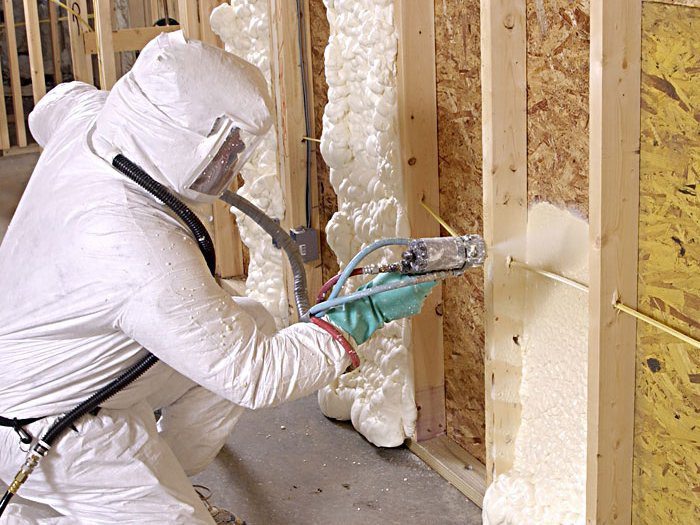The Environmental Impact of Spray Foam: Sustainability Factors To Consider
Just How Spray Foam Can Boost Energy Effectiveness in Any Type Of Structure
Spray foam insulation has actually arised as a crucial remedy for boosting power performance throughout different structure kinds. As home proprietors significantly look for sustainable options, the implications of spray foam insulation extend beyond mere utility savings.
Comprehending Spray Foam Insulation
Spray foam insulation is increasingly identified for its superior thermal efficiency and flexibility in different applications. Composed mostly of polyurethane, this insulation material is applied as a fluid that increases upon get in touch with, filling spaces and producing a seamless obstacle. This special residential property permits spray foam to adhere to uneven surfaces, making it a suitable choice for both household and industrial frameworks.

Application of spray foam insulation is generally performed by trained specialists making use of specific tools, making certain optimal performance and safety - Spray Foam. The curing procedure is rapid, enabling for fast setup and very little interruption. As an outcome, spray foam insulation is increasingly being employed in new building and construction and retrofitting tasks due to its ability to improve structural stability while enhancing total power performance in structures
Advantages of Energy Efficiency
Energy efficiency plays an essential function in decreasing operational costs and minimizing environmental impact throughout numerous markets. By enhancing energy usage, businesses and home owners can accomplish significant savings on energy expenses, which directly boosts monetary performance. Reliable power consumption means much less reliance on fossil fuels, therefore adding to a reduction in greenhouse gas exhausts and advertising a more lasting atmosphere.
Furthermore, energy-efficient buildings usually experience boosted building values. As energy expenses rise and sustainability becomes a concern for consumers, homes with enhanced power efficiency attributes are much more eye-catching on the marketplace. This trend encourages financial investment in energy-saving innovations, which can further drive technology and economic growth.
In enhancement to ecological and financial advantages, energy effectiveness can also enhance the total comfort and health and wellness of interior spaces. Appropriate insulation and reliable heating & cooling systems aid maintain constant temperature levels, reducing drafts and humidity levels, which consequently can lead to better indoor air top quality.
Inevitably, the benefits of energy effectiveness expand beyond immediate cost savings, cultivating a resistant economy, advertising environmental stewardship, and improving the lifestyle for owners in any building.
How Spray Foam Works
Normally used as a fluid, spray foam expands rapidly upon contact with surfaces, forming a solid barrier that successfully secures spaces and splits. This one-of-a-kind residential property results from its chemical make-up, largely being composed of isocyanates and polyols, which react when blended to develop a foam that loads gaps and sticks to different materials, including steel, timber, and concrete.
When applied, the foam expands to several times its initial quantity, making certain a tight seal that avoids air leak. This procedure dramatically minimizes thermal bridging, which takes place when heat transfers via products, bring about power loss. The foam's high R-value, a procedure of thermal resistance, contributes to improved insulation by decreasing warm transfer between the exterior and interior atmospheres.
Additionally, spray foam is immune to wetness and insects, further boosting its effectiveness in maintaining power efficiency. Its application can be customized to different areas, consisting of attics, wall surfaces, and crawl areas, optimizing insulation throughout a building. Spray Foam. Generally, the ingenious design and application technique of spray foam make it an effective option for improving power my company efficiency in any kind of structure, bring about decreased power costs and an extra sustainable developed environment

Applications in Numerous Buildings
Many applications of spray foam insulation can be found across different structure types, improving power performance and comfort. In domestic homes, spray foam is usually utilized in attic rooms and wall surfaces to create a seamless obstacle versus air leakages, significantly decreasing heating and cooling down needs. This application is specifically useful in older homes, where typical insulation might be inadequate.
In industrial structures, spray foam insulation is put on roofing system systems and outside wall surfaces, which aids to boost thermal performance and protect against moisture invasion. Its light-weight nature makes it an optimal option for retrofitting existing frameworks without including significant weight. Additionally, spray foam can be utilized in commercial setups to protect pipes and storage tanks, preserving temperature control for sensitive materials.
Institutional structures, such as hospitals and schools, take advantage of spray foam insulation by making certain a regular interior environment that supports passenger comfort and health. The flexibility of spray foam enables it to adapt to various structure forms and dimensions, making it a favored choice for architects and builders looking for reliable insulation options. Generally, spray foam insulation works as a vital element in accomplishing energy-efficient buildings across all sectors.
Long-Term Cost Cost Savings
Spray foam insulation offers significant lasting expense savings for structure proprietors and residents by lowering power consumption and decreasing utility bills. By supplying a remarkable air seal, spray foam reduces the seepage of outside air, therefore boosting the thermal performance of a structure. This leads to much more reliable heating and cooling down processes, which can bring about substantial reductions in power costs in time.
Along with instant cost savings on energy bills, the durability and longevity of spray foam insulation add to its financial advantages. Unlike typical insulation materials, which might sag, clear up, or deteriorate, spray foam preserves its performance for decades, minimizing the need for regular substitutes or repair work. This durability equates to decrease upkeep prices and much less disruption for passengers.
Moreover, buildings equipped with spray foam insulation usually enjoy a boost in home worth, making them a lot more appealing to potential purchasers or occupants. As power efficiency becomes progressively prioritized, properties with effective insulation services attract attention in the market. Ultimately, the integration of spray foam insulation not only enhances comfort but also represents a tactical investment that yields significant financial benefits over the long-term.
Conclusion
In conclusion, spray foam insulation functions as a vital component in boosting power performance throughout varied building types. Its ability to create a smooth obstacle against air leakage, combined with moisture-resistant buildings and high r-values, dramatically lowers power usage and associated prices. The application of spray foam not just adds to consistent interior temperature levels however also raises building worth, underscoring its duty as a sensible investment for both commercial and household buildings.
Spray foam insulation has emerged as an essential service for boosting energy efficiency throughout various structure types. Spray Foam. As an outcome, spray foam insulation is increasingly being used in new building and construction and read this article retrofitting jobs due to its ability to improve structural stability while improving general energy performance in buildings
Generally, the innovative layout and application method of spray foam make it a reliable service for improving energy performance in any framework, leading to decreased power costs and a much more sustainable developed setting.
Various applications of spray foam insulation can be discovered throughout different structure types, boosting about his energy effectiveness and convenience.In conclusion, spray foam insulation serves as an essential element in improving energy effectiveness throughout varied structure kinds.